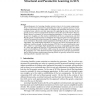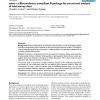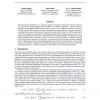777 search results - page 69 / 156 » Structured Weight-Based Prediction Algorithms |
EC
2006
13 years 9 months ago
2006
The performance of a learning classifier system is due to its two main components. First, it evolves new structures by generating new rules in a genetic process; second, it adjust...
BMCBI
2005
13 years 8 months ago
2005
Background: Genome wide microarray studies have the potential to unveil novel disease entities. Clinically homogeneous groups of patients can have diverse gene expression profiles...
ICML
2007
IEEE
14 years 9 months ago
2007
IEEE
In many prediction tasks, selecting relevant features is essential for achieving good generalization performance. Most feature selection algorithms consider all features to be a p...
CORR
2010
Springer
13 years 7 months ago
2010
Springer
Structured output prediction is an important machine learning problem both in theory and practice, and the max-margin Markov network (M3 N) is an effective approach. All state-of-...
ICNSC
2008
IEEE
14 years 3 months ago
2008
IEEE
— This paper presents an approach to the multiple sequence alignment (MSA) problem by applying genetic algorithms with a reserve selection mechanism. MSA is one of the most funda...



